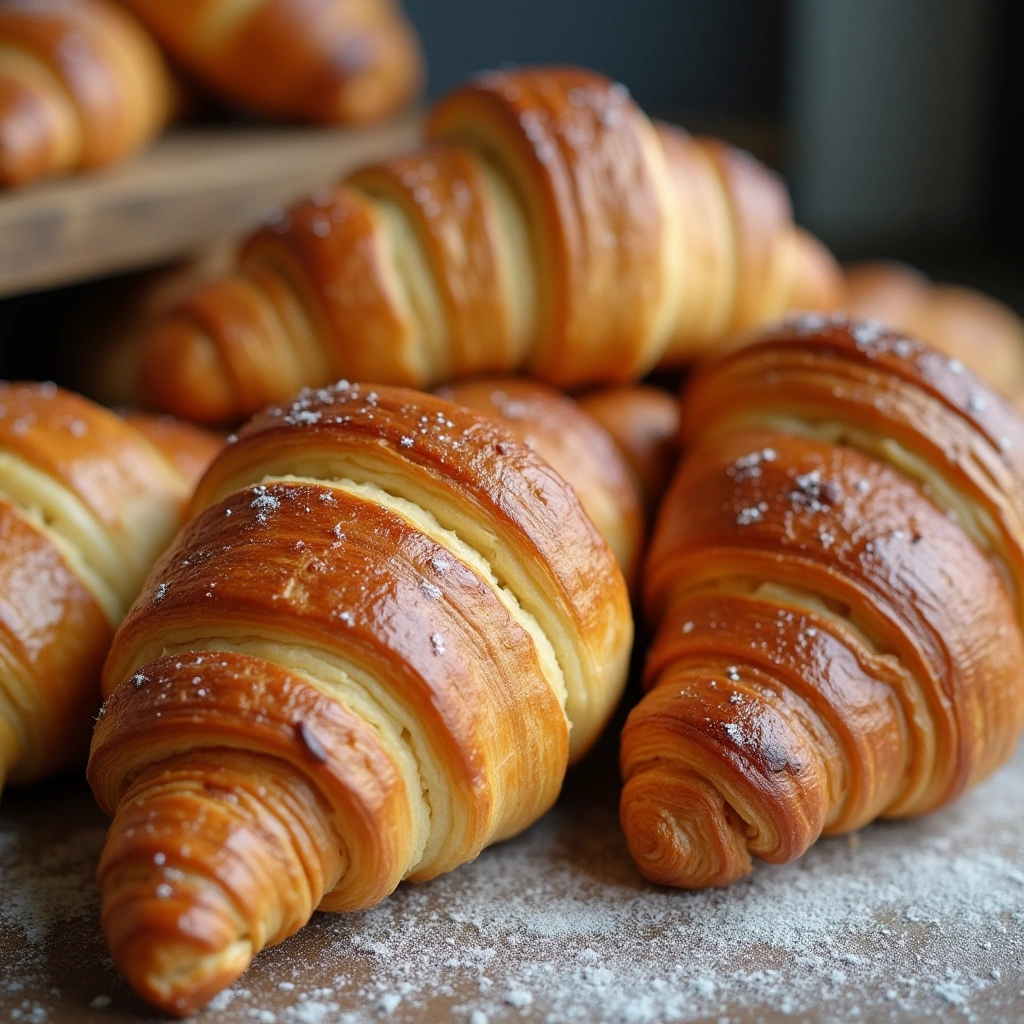As the aroma of freshly baked pastries fills the air, you’re instantly taken to a Swiss bakery. The golden-brown outside gives way to a soft, flaky inside. This reveals the rich, buttery taste that makes Gipfeli, the Swiss croissant, so loved1. This Gipfeli recipe will help you make these pastries at home, whether you’re experienced or new to baking.
Gipfeli are like Swiss croissants but with their own special touch1. They are denser and less buttery than French croissants, yet still very tasty1. This guide will teach you how to make these flaky, layered treats. You’ll learn how to make the dough, laminate it, and shape it into the famous crescent shape.
Table of Contents
Understanding Swiss Gipfeli: A Traditional Delight
Gipfeli is a Swiss pastry loved for centuries. It gets its name from the German word “Gipfel,” meaning “peak.” This refers to its unique crescent shape, different from the French croissant. Gipfeli is denser and sweeter, thanks to its yeast dough and butter or margarine2.
Origins and Cultural Significance
Gipfeli, or kipferi, is deeply rooted in Swiss culture, especially in German-speaking areas. It’s a favorite for breakfast and a mid-day treat. Gipfeli is more than food; it’s a symbol of Swiss identity and culinary tradition3.
Gipfeli vs. French Croissants
Though similar in shape, Gipfeli and croissants are different. Gipfeli uses high-protein flour for flaky layers2. The dough’s butter content is key to its texture and taste2.
Role in Swiss Cuisine
Gipfeli is a key part of Swiss food traditions, especially in German-speaking areas. It’s enjoyed with coffee in the morning or as a snack. From plain to Mandelgipfeli (almond paste) or Nussgipfeli (Nutella), Gipfeli delights everyone3.
Gipfeli’s lasting appeal in Switzerland shows the country’s rich food culture. Making these flaky pastries opens a world of tradition and joy. It’s a journey through Swiss baking history, loved by many.
Essential Ingredients for Perfect Gipfeli
Making the perfect Swiss gipfeli starts with choosing the right ingredients. You’ll need all-purpose or bread flour4, active dry yeast4, and lots of unsalted butter4. Add some sugar4 and salt4 for taste, and warm milk4 to mix it all together. This creates a dough that’s soft and brioche-like.
For a sweet twist, try adding ground almonds5, cinnamon, or5 apple juice. A sprinkle of5 powdered sugar on top makes these breakfast pastries even more special. Making a great Swiss croissant is all about using the best ingredients and paying attention to every detail.
“The quality of the butter is the key to unlocking the flaky layers that define a true gipfeli.”
Whether you’re making traditional gipfeli or trying out new butter rolls, the right ingredients are key. With 83% flour6, 12.5% cold butter, and careful attention to baking time and temperature6, you can make perfect gipfeli every time.
Creating the Perfect Gipfeli Recipe
Making the perfect Gipfeli, a Swiss croissant, is all about the yeast dough and lamination7. You’ll need flour, sugar, salt, yeast, warm milk, cold butter, and an egg for brushing7.
Preparing the Base Dough
Start by letting the yeast dough rise to double its size, which takes about 1 hour in a warm place7. Then, roll out the dough and fold it with cold butter two times. This creates the flaky layers7.
Chill the dough for about 1 hour. Roll it out, cut into triangles, and shape into crescents. Let them rise for 30 minutes7.
Mastering the Lamination Process
Lamination is key for flaky Gipfeli. Mix dough and cold butter layers for a crispy crust and soft inside7. Keep the dough at the right temperature and rest it correctly to keep the butter layers intact7.
Shaping Techniques for Flaky Layers
After laminating, shape the dough into Gipfeli. Roll out the dough, cut into triangles, and roll them into crescents7. Let them rise for 30 minutes before baking for flaky layers7.
Mastering Gipfeli making, from dough to shaping, lets you create delicious butterzopf7. Try different flavors and enjoy with fruit, jam, or coffee7.
The Art of Butter Layering
In the world of Swiss baking, butter layering is key. It makes the Gipfeli flaky. This technique involves folding and rolling cold butter into the dough. It creates thin layers that separate when baked, making the pastry flaky8.
Keeping the dough cold is crucial. It stops the butter from melting too soon. This ensures the butter and dough layers stay distinct, creating up to 54 layers9.
This process takes time and skill. It can take a professional baker up to 3 years to get it right9. The result is a pastry that’s both light and rich. It’s buttery and melts in your mouth10.
| Key Factors in Butter Layering | Importance |
|---|---|
| Maintaining Proper Temperature | Prevents premature butter melting, preserving distinct layers |
| Precise Folding Patterns | Creates up to 54 distinct layers of butter and dough |
| Chilling the Dough | Allows for controlled butter incorporation and layer development |
Mastering butter layering turns the Gipfeli into a Swiss delight. It becomes a pastry that looks great and tastes amazing.
Step-by-Step Shaping Guide
Learning to shape Swiss gipfeli, or croissants, is crucial. It makes these pastries flaky and buttery. After mastering lamination, you’ll roll, cut, and shape the dough into crescents. Here’s how to achieve pastry perfection step by step.
Rolling and Cutting the Dough
Begin by rolling out the laminated swiss croissant recipe dough into a large rectangle, about 1/4 inch thick11. Use a sharp knife or pizza cutter to cut the dough into triangles. The wide end is the base, and the narrow end is the crescent’s tip11.
Forming the Classic Crescent Shape
Roll each triangle from the wide base to the narrow tip to form the crescent shape12. Handle the dough gently to keep the flaky, buttery viennoiserie layers intact13.
Pre-baking Preparation
Place the shaped gipfeli on a baking sheet, curving them slightly with the tip tucked under12. Let them proof for 2-5 hours to develop flaky layers13. Brush with a beaten egg wash for a golden finish11.
Follow this guide to make authentic Swiss gipfeli. You’ll impress everyone with your flaky, buttery pastries. Enjoy the art of lamination and shaping, and savor the Swiss viennoiserie tradition.
Mastering the Baking Process
Making the perfect artisan baking masterpiece needs careful attention to the baking steps. For Swiss baking and the famous butter croissant called Gipfeli, being precise is crucial14.
Start by heating your oven to 400°F (200°C). This heat makes the butter in the dough melt. It creates the steam that makes the layers flaky and buttery14.
Then, brush the dough with an egg wash for a shiny, golden look. Bake the pastries for 18-20 minutes, until they’re just right15.
The secret to success is the right oven temperature and timing. This balance lets the European bakery technique of laminated dough work its magic. It creates the layers that make the Gipfeli special14.
After baking, let the Gipfeli cool on a wire rack. This step helps set their structure and keeps them flaky15.
| Ingredient | Amount |
|---|---|
| Swiss Pastry Flour | 500 grams |
| Unsalted Butter | 250 grams |
| Active Dry Yeast | 10 grams |
| Granulated Sugar | 50 grams |
| Salt | 10 grams |
| Large Egg | 1 |
By mastering the baking process, you’ll make delicious Swiss baking treats. They will amaze your taste buds and impress your friends1415.
Sweet and Savory Filling Variations
Gipfeli, a Swiss breakfast favorite, can be enjoyed in many ways. You can have it plain or with a variety of tasty fillings. From classic Swiss tastes to new ideas, you can make this layered dough pastry your own16.
Traditional Swiss Fillings
The traditional fillings for gipfeli include almond paste, making the Mandelgipfel, and rich chocolate, making the Nussgipfel. These Swiss recipes bring a taste of tradition that has lasted for years16.
Modern Flavor Combinations
Bakers have come up with new fillings for gipfeli. They love using Nutella, ham and cheese, or spinach and feta. These new flavors give the traditional Swiss pastry a fresh twist16.
Creating Custom Fillings
Gipfeli dough is perfect for making your own fillings. You can use fruit compotes, nut pastes, or savory spreads. The only limit is your imagination, making gipfeli a fun project for bakers16.
It’s important to mix the filling into the dough before shaping. This way, the flavors blend together perfectly. It makes every bite a joy16.
Gipfeli is great whether you like traditional or modern flavors. It’s a chance to be creative and make your breakfast special. Try different fillings to make your gipfeli even more delicious16.
Storage and Reheating Tips
Enjoy your freshly baked Gipfeli, but don’t worry if you have leftovers. These delightful breakfast pastries can be stored for later enjoyment. Keep Gipfeli in an airtight container at room temperature for up to 3 days17. For longer storage, you can freeze shaped, unbaked Gipfeli and bake them straight from the freezer, adding a few extra minutes to the baking time17.
When it’s time to reheat your Gipfeli, the oven is your best friend. Preheat your oven to 350°F (175°C) and warm the pastries for about 5 minutes to restore their crisp, flaky texture17. Avoid the microwave, as it can make the Gipfeli soggy. For frozen Gipfeli, simply bake them directly from the freezer for 10-15 minutes17.
Whether you’re enjoying fresh or reheated Gipfeli, these buttery, homemade breakfast pastries are sure to delight your taste buds. With these storage and reheating tips, you can savor the flaky pastries anytime, perfect for a cozy homemade baking experience or a delightful bakery recipes treat.
FAQ
What is Gipfeli?
Gipfeli is a Swiss pastry loved by many. It’s like French croissants but denser and less buttery. This gives it a milder taste.
What are the key ingredients for making Gipfeli?
To make Gipfeli, you need flour, yeast, and unsalted butter. Also, milk, sugar, and salt are important. You can add ground almonds, cinnamon, apple juice, and powdered sugar for extra flavor.
How is the Gipfeli dough prepared and laminated?
First, you make a yeast dough and let it rise. Then, you add butter and roll it out. This process is repeated to create layers. This makes the pastry flaky.
What is the significance of butter layering (lamination) in Gipfeli?
Lamination makes Gipfeli flaky. Cold butter is folded into the dough to create layers. These layers separate when baked, giving the pastry its flaky texture.
How are Gipfeli shaped and baked?
The dough is rolled into a rectangle and cut into triangles. Each triangle is rolled into a crescent shape. They’re placed on a baking sheet and baked at 400°F for 18-20 minutes.
What are some traditional and modern filling variations for Gipfeli?
Gipfeli can be enjoyed plain or filled. Traditional fillings include almond paste and chocolate. Modern options include Nutella, ham and cheese, and spinach and feta. You can also use fruit compotes or savory spreads.
How should Gipfeli be stored and reheated?
Enjoy Gipfeli fresh, but they can be stored for up to 3 days. Freeze them if you want to keep them longer. To reheat, bake at 350°F for 5 minutes. Don’t microwave them as it makes them soggy.

